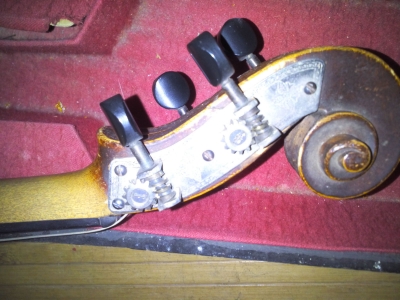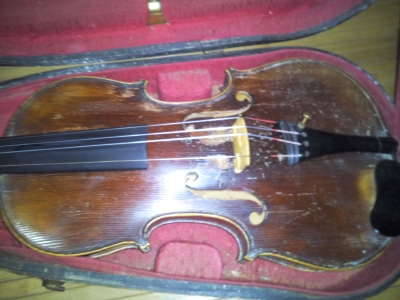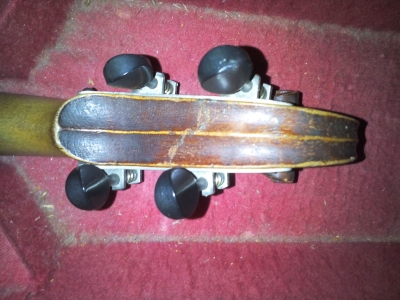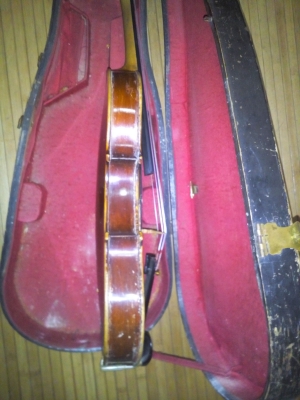Welcome to our forum. A Message To Our New and Prospective Members . Check out our Forum Rules. Lets keep this forum an enjoyable place to visit.
Currently working on errors from the latest (SimplePress) forum update. Many issues have been resoled and others are being worked on. Thank you for your patience.
 Topic RSS
Topic RSS



 (0 votes)
(0 votes) Member
 Offline
OfflineHello I recently purchased an older violin which I replaced the sound post in. (Thanks Fiddlerman for the tutorials.)
Now my question is a general one. What do you look for to determine if a violin is "Good" I Could care less about value, or the snobbery. I just mean what are the signs of it being made well.
The violin I have doesn't really have a flamed back at all, but the other all corners cut except bling trade fiddle I got does. Which makes me wonder if the wood on the one I just bought is even maple. I've seen a few fiddles around made from different tone woods.
I know what people constantly knock down on fiddles. I've seen the "typical" forums were anything under 5k is considered firewood. So I'm looking for more of a grounded opinion. I will post pictures tomorrow of the violin I got after I put new strings on it.











... I'll leave more technical details to the more experienced - but in essence "there's many a good tune played on an old fiddle".
My only thoughts are - depends how "old" the instrument is - in the sense of "has it ever been damaged and repaired". Even on brand-new factory instruments (as evidenced by a couple of forum members who had bad experiences buying new - NOT I should say from FiddlerShop) - various defects have been seen - improperly glued top / bottom / ribs etc. Forced / damaged peg holes, loose/improperly glued internals (blocks, bass bar rattle etc ). It may be worth inspecting these visual / physical aspects, which could have come from just a poorly fabricated instrument, or an improperly repaired one.
As for sound / tonality - they're all going to be different - but I would expect a "reasonably consistent volume and response" across all open strings with the same (well, similar) bowing action - with - most likely - the open A sounding somewhat more "present" than the rest (as it is approaching the internal natural resonance of the cavity - often around Bb)
I would do the same test, bowing further up the strings as well, and observing how "constant or otherwise" a tone you can draw from the instrument. Look / listen for "unexpected" or "un-natural" resonances or "wolfing" (often curable by one trick or another).
Talking of "body resonance" - I would also look for sympathetic / inter-string resonances (usually desirable, giving the instrument its more complex tone) - the ear is quite sensitive to this - and by dampening a sympathetic string resonance with a finger while bowing the intended note you can hear the nature of the sound change.
Very often, the entire nature of an instrument can of course be changed by virtue of changing the string types.
I am with you on "looks and cost ain't everything" - if it sounds OK, then to my simple way of thinking, it's worth playing. It may not have the responsiveness or projection of a 5K instrument (which I would love to try I might add, just out of interest) - but - firewood - NOOOOOO.... NEVER !!!!!!!!!
Keep us advised !
I seriously recommend not copying my mistakes. D'oh -
Please make your own, different mistakes, and help us all learn :-)








The notion that under 5K is firewood is just a bunch of silliness.
Have you ever heard Pierre play a 99$ violin... 🙂
That being said.. I could be partial as I don't have a 5K violin and to me it sounds pretty dang good.
I think a violin is good when it sounds good and it is in the hands of someone who can play it well.
🙂
Cheers and hello! I can't wait to see your pictures...
Vibrato Desperato.... Desperately seeking vibrato
Member
 Offline
Offline








 I had car issues today which left me stranded for a few hours. I can post post up the ebay photos from when I purchased it. I replaced the strings on it with perlone strings. Not the fiddlerman's, but after stringing it up and tuning it. It projects quite well. I am just learning how to play but how "even" it was for me to bow across the strings with this instrument compared to the chinese one is something I like.
I had car issues today which left me stranded for a few hours. I can post post up the ebay photos from when I purchased it. I replaced the strings on it with perlone strings. Not the fiddlerman's, but after stringing it up and tuning it. It projects quite well. I am just learning how to play but how "even" it was for me to bow across the strings with this instrument compared to the chinese one is something I like.
I looked over the back in some bright light and it does have flame to it, but it's very subdued. It's been worked on, but the inside of the instrument is very clean. The ribs around the end peg at one point had some damage and it was repaired along time ago. It is slightly opened at the bottom(Just looks like the hide glue just separated slightly), but I have of heard of people playing professionally with instruments that have similar issues and nobody bats an eye.
The fingerboard and nut are ebony and were worked on by a luthier. The bridge was cut by a luthier on some date in 08... Not sure if thats 2008 or 1908.. The chin rest on this violin has a patent date of march 22 1883! And its honestly one of the nicest chin rests I've felt. Its small and fits comfortably under my chin.
I heard people constantly argue about how heavy the mechanical tuners are and how they lopsided the weight. I haven't felt that at all. The scroll is fully cut, and there is a pegbox crack (Evident from the photos) that was repaired. It is solid. The Mechanical tuners on it weight absolutely nothing, I am convinced they weight the same as ebony pegs (Or maybe even maple pegs like I put in my fiancee's violin). Also one advantage to those mechanical tuners for me at least is compared to the chinese violin I got.. I can actually fine tune it up there, I did not even need to use the fine tuner on the E to tune it up.
But after stringing it up and going across the strings, it sounds very nice, but boy did it wake me up. I can see maybe why somebody stuck the original sound post so far towards the tailpiece the thing is louder then my chinese violin. Not in a bad way it just booms.
I can tell that somebody played the snot out of this thing. Theres sign of wear and tear on it and honestly I love that patina, and from the sound it made was pleasing to me. I am not able to play anything but I can see me growing into this instrument.
When I get the chance tomorrow I will see if I can take some slightly better pictures.. It is not a "Pretty" fiddle, but dangit it's my fiddle 😀 I am just pleased I was able to cut a sound post and fit in there.
Regulars
 Offline
Offline



If you enjoy it it has worth. It looks like a decent enough fiddle, that chin rest is super cute.
i bought a cheap eBay violin over a year ago and it's been good to me. It took a little love and attention, needed a few minor "repairs", new chin rest, bridge, tail piece and strings. Mines from before the 1920s and like yours someone played it hard and regularly, this is a good sign. Someo e thought it sounded good enough to play often.
Give it it time to wake up a little and I bet the booming sound will get bigger, mine did.
Member
 Offline
OfflineYes, it may have been cheap and I was the only one bidding on it. But it feels good in the hands, it rests nice and I do not have to "fight it" to get comfortable. The fact it is from the 1800's is a bit interesting to me, I do not know if it was repaired in the 1800s after the chin rest was added on. it came from florida. The tail piece says made in germany on it, so I have no clue what is original to it. Or it's age. It could be early 1800's and repaired through out that century until 1908 as far as I can figure.. only to be sold to me now. the strings were VERY old on it. Theres no label on the inside of it.. or even a sign of a label being there. I wonder if it is an american made fiddle.
One does wonder what life these instruments had. If only they could talk the stories they could tell.
1 Guest(s)


 Log In
Log In Register
Register










